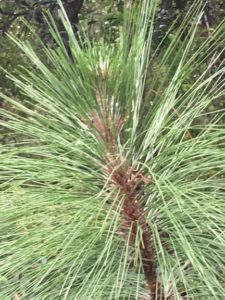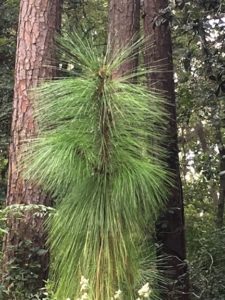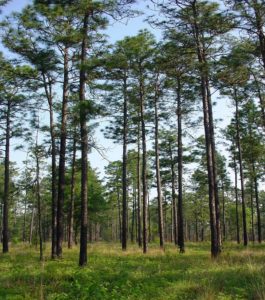 Long-leaf pines, Pinus palustris, are among the most beautiful, important and threatened of all southern trees. At one time long leaf pine ecosystems covered the southeastern United States, roughly 90 million acres. Today, a mere 3 1/2 million acres persist, mostly in South Georgia, Alabama and northern Florida.
Long-leaf pines, Pinus palustris, are among the most beautiful, important and threatened of all southern trees. At one time long leaf pine ecosystems covered the southeastern United States, roughly 90 million acres. Today, a mere 3 1/2 million acres persist, mostly in South Georgia, Alabama and northern Florida.
This species has shown amazing resiliency and has been able to withstand many of the adverse effects of climate change. Neither windstorms, pests, wildfires or drought can kill these trees. So what’s happening to them?
It’s the usual culprit, a loss of land due to urbanization. But another suspect is guilty as well – fire. This is not the destroying kind, but the life giving kind. Long leaf pines are dependent on fires for seed germination. The seeds of this tree have to come into contact with the soil to germinate and frequent fires burned off leaf litter and understory plants, allowing this to happen. The fire suppression which occurred with the change in land use had a adverse effect on the ecosystem.
 So who needs long leaf pines? The U.S. Fish and Wildlife Service estimates that over 100 different species coexist in these ecosystems, making it one of the most diverse in the world. Today, long leaf pine forests support thirty species that are considered endangered or threatened. In addition, long leaf pines have the capacity to “clean the air” by absorbing harmful carbon pollution from the atmosphere.
So who needs long leaf pines? The U.S. Fish and Wildlife Service estimates that over 100 different species coexist in these ecosystems, making it one of the most diverse in the world. Today, long leaf pine forests support thirty species that are considered endangered or threatened. In addition, long leaf pines have the capacity to “clean the air” by absorbing harmful carbon pollution from the atmosphere.
Unlike other trees, long leaf pines spend the first several years in a “grass stage” where there is little above ground growth but tremendous growth of the taproot, which eventually can measure up to 12 feet long. After this incubation period, the trunk grows quickly and can reach 80 – 100 feet tall and live 250 years. The tree almost always has a straight trunk and thick bark that helps protect it from fire and from damage from the southern pine beetle.
The long leaf pine ecosystem is considered so important that several different organizations from many different states have banded together to protect and nurture the remaining ecosystems. Steps to success include planting seedlings, prescribed burning, managing native ground covers and controlling invasive species.
It’s worth a trip to the South to see this beautiful, fragile ecosystem. Stop by and say “hi” when you do.

If you have not read EO Wilson’s book, “Anthill”, you should.
Thanks, Clay. I love EO Wilson but have not read Anthill. Thanks for the suggestion.